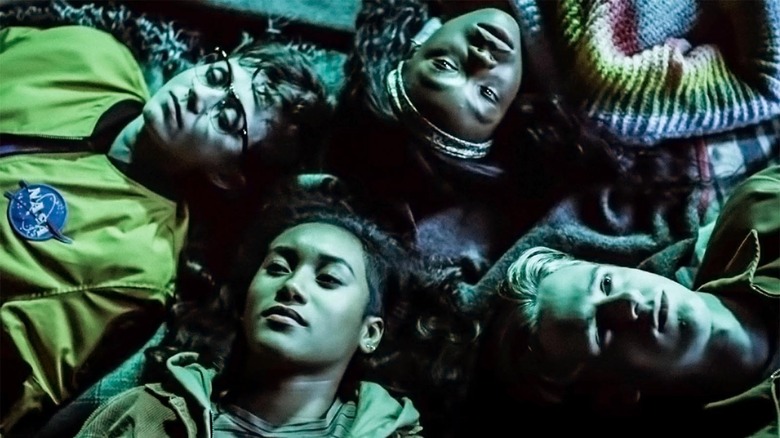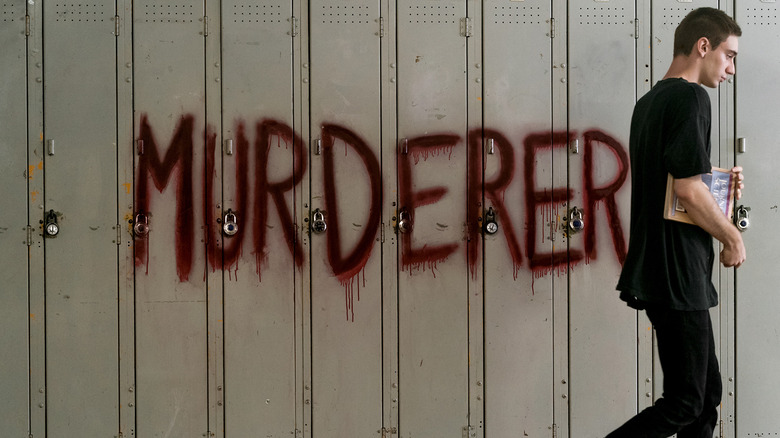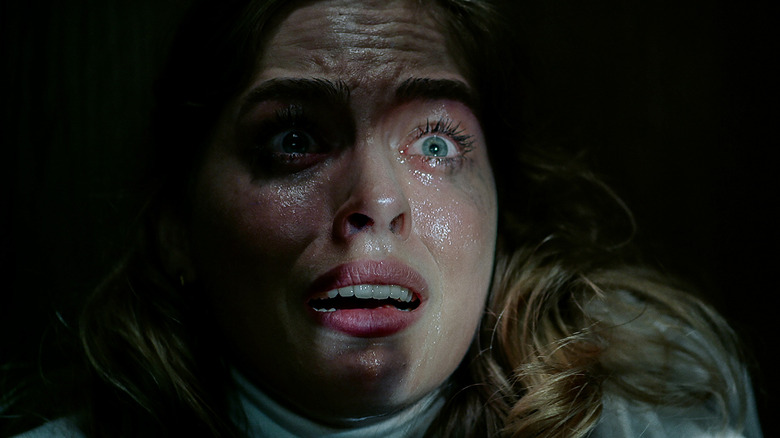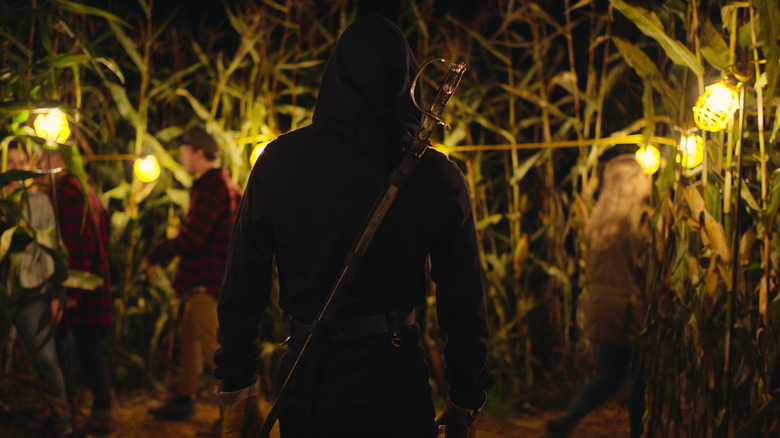There's Someone Inside Your House Review: A Slasher For A New Generation
After the smashing success of the "Fear Street" trilogy, Netflix continues its train of slasher films for today's young adult audiences with the gory teen scream "There's Someone Inside Your House." Based on Stephanie Perkins' romance-with-a-sprinkle-of-murder novel of the same name, "There's Someone Inside Your House" just celebrated its premiere at Fantastic Fest. Taking inspiration from '90s and '00s slasher films and combining them with the sensibilities of today's more socially conscious youth, "There's Someone Inside Your House" is an advantageous slasher perfect for the upcoming Halloween season.
The film starts with an opening kill that many have unfairly compared to Casey Becker's death in "Scream," focusing on the brutal killing of a relatively unsympathetic football player named Jackson. He's introduced as a pretty stereotypical jock, but his unlikability skyrockets when his killer reveals they know his secrets. Namely, brutalizing his gay teammate under the guise of hazing.
As the killer approaches Jackson pleads for his life, claiming "that's not who I am!" — only to realize the killer is wearing a mask of his own face. The "Scream" comparisons are unwarranted because this kill isn't a "gotcha" reveal; it's a brutal cold open and a pretty satisfying one considering the victim is a real piece of work. It isn't every day that a slasher film opens with a kill you actively want to see happen.
Meet Your New Best Friends
News of the star quarterback's death divides the school, with the obvious melodramatic devastation of his teammates and fellow jocks, and our cast of sardonic outcasts struggling to find empathy for the murder of someone who made their lives hell for years. Here we meet our protagonist, Makani (Sydney Park), who fled Hawaii after a traumatic event to start a new life for herself in rural Nebraska.
Makani is joined by gender non-conforming Darby (Jesse LaTourette), head bitch in charge Alex (Asjha Cooper), passionate slacker Rodrigo (Diego Josef), rebellious son of the richest man in town Zach (Dale Whibley), and gay football player Caleb (Burkely Duffield), whom the crew adopts into their friend group after the entire school is convinced he killed the football player in response to his hazing.
In previous years, such a diverse group of friends would feel out of place or like a forced agenda, but "There's Someone Inside Your House" is quite reflective of the face of Zoomer friendships. Obviously cliques will always exist, but today's teens tend to blur the lines of their social groups. This is the face of a modern friend group and in rural Nebraska, it makes perfect sense that the kids outside of the status quo would find community in one another.
Yet, there's even an outcast from the outcasts: Théodore Pellerin's character, Oliver, whom everyone is convinced is "a sociopath" and is Makani's secret boyfriend. The roots of the romance plot in the novel exist in the relationship between these two, but much like most of our high school relationships, there's really nothing mountain-moving about their love. They're just two teens that get each other on a level their friends don't seem to understand, and it leads to late-night makeout sessions in cars. They'll forget about each other in a couple of years. This might sound like a criticism, but as a staunch supporter of normalizing "meh" relationships in high school movies, I'm all for it.
A Pattern Emerges
Following the death of the quarterback, the killer takes down the student-body president in the middle of a church, once again donning a mask that resembles the victim's face. Her death is absolutely gruesome and, again, one you want to root for once the killer reveals the "secret" deeming her worthy of their targeting. By and large, slasher films usually introduce us to a core group that we watch get picked off one by one, but "There's Someone Inside Your House" takes a completely different approach — and one that might upset slasher genre purists.
In the vein of "Cherry Falls," once the killer's pattern is revealed the teens take it upon themselves to throw a party where they reveal all of their secrets. Everyone starts spilling the beans except for Makani, whose continued dedication to secrecy makes her an easy future target. We do, of course, finally learn the truth of her past, and despite how long the film takes to divulge the information there is an emphasis on Makani's autonomy to tell her own story that's incredibly refreshing.
During the secret purging party, Zach confesses that his ultra-powerful father is also the owner of the 10th largest collection of Nazi memorabilia in North America. Is it a cheap way to paint him as completely deplorable? Obviously. But when Zach shows that he's also modified the weapons and war trumpets into weed paraphernalia, the film feels like a perfect capture of blind teen rebellion. Even these kids who all express throughout the film their social justice consciousness are quick to smoke up without ever contemplating the ethics of using a WWII gas mask as a bong. At the end of the day, no matter how "woke" they appear to be, they're still teenagers, and the movie never loses sight of that.
Admittedly, the reveal of the killer is somewhat lackluster as some basic movie sleuthing points directly to the killer's identity almost from jump street, but in a movie that's more about working together as a community to get through a tragedy than it is about individualistic survival, it almost doesn't matter. Sydney Park's Makani is our de-facto final girl as the protagonist, but "There's Someone Inside Your House" is far more interested in trying to save as many people as possible without it feeling like a do-good hero story.
What Makes There's Someone Inside Your House Special
Director Patrick Brice ("Creep," "Creep 2") and screenwriter Henry Gayden ("Shazam!") aren't trying to subvert an entire genre like "Scream" nor are they trying to capture the nostalgia of the era like the "Fear Street" trilogy. The humor scattered throughout feels authentic to the characters and the generation, not an attempt to wink at the camera the way more meta slashers are known to do.
As far as a slasher is concerned, it's an interesting enough entry to such a colossal subgenre and the kills are immensely fun to watch, but the film could have benefited from a little more insight into the killer's process. There is a fantastically camp monologue upon reveal that feels like a spiritual successor to Rebecca Gayheart in "Urban Legend," though, and I'm here for it. But where the film truly shines is in its effective capturing of teenage life.
Teenagers have always been the bleeding heart of slasher films, but few have ever managed to genuinely capture the complications of teenage existence. These characters aren't just bodies lining up for the slaughter, they're veritable people with their own issues. If there's any "Scream" comparison to be made, it's this one. Even characters that aren't given as much time to explore on screen feel fully realized, and the way the different relationships within the friend group function are easily identifiable. These aren't archetypal slasher stereotypes of the past, as "Cabin in the Woods" correctly identified; they're just friends who happen to have varying interests.
There's a sense of comfort in the tried-and-true slasher formula, but it also sets such a limitation on creativity and progress. Part of the brilliance of the slasher boom in the late '90s and early '00s was not because they were doing anything particularly groundbreaking, but because they were bucking trends and breaking well-established rules. "There's Someone Inside Your House" doesn't break slasher rules; it simply chooses to act like Common Core math and get to the same outcome from a process that older generations might find frustrating or ineffective. It feels like a perfect allegory for the generational shift currently happening between Millennials and Gen Z and a welcome addition to the new wave of horror.
"There's Someone Inside Your House" releases October 6, 2021, on Netflix.



